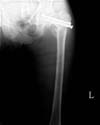Abstract
Iatrogenic fracture is not popular and might be recognized as a malpractice. Surgical error related to iatrogenic fracture which has occurred after an operation can be detected only by a surgeon. Stress riser fracture is another form of iatrogenic fracture also known as a Young's modulus fracture. As the majority of surgical related stress riser fractures can be preventive, the accurate prevalence is not known. The majority of fractures occurred in the weight bearing bones such as femur and tibia. The subtrochanter area is the most stress concentrated area in the human body, thus it is a common area for occurrence of stress riser iatrogenic fractures. We experienced 2 cases of stress riser iatrogenic fractures, which are related to technical errors, thus we report cases with literature review.
Figures and Tables
Fig. 2
Three cannulated screws were too clustered and empty screw holes remained in the lateral cortex which is not seen in the plain X-ray.

References
1. Bennell KL, Malcolm SA, Brukner PD, et al. A 12-month prospective study of the relationship between stress fractures and bone turnover in athletes. Calcif Tissue Int. 1998; 63:80–85.

2. Johnson AW, Weiss CB Jr, Wheeler DL. Stress fractures of the femoral shaft in athletes: more common than expected. A new clinical test. Am J Sports Med. 1994; 22:248–256.

3. Kelly EW, Jonson SR, Cohen ME, Shaffer R. Stress fractures of the pelvis in female navy recruits: an analysis of possible mechanisms of injury. Mil Med. 2000; 165:142–146.

4. DiMaio FR, Haher TR, Splain SH, Mani VJ. Stress-riser fractures of the hip after sliding screw plate fixation. Orthop Rev. 1238; 21:1229–1231. 1238
5. Lung YT, Kam WL, Leung YF, Chung OM, Wai YL. Subcapital femoral neck fracture following successful trochanteric fracture treatment with a dynamic hip screw: a report of five cases. J Orthop Surg (Hong Kong). 2007; 15:238–241.

6. Shaer JA, Hileman BM, Newcomer JE, Hanes MC. Femoral neck fracture following hardware removal. Orthopedics. 2012; 35:e83–e87.

7. Mendez AA, Joseph J, Kaufman EE. Stress fractures of the femoral neck following hardware removal from healed intertrochanteric fractures. Orthopedics. 1993; 16:822–825.

8. Howard CB, Davies RM. Subtrochanteric fracture after Garden screw fixation of subcapital fractures. J Bone Joint Surg Br. 1982; 64:565–567.





 PDF
PDF ePub
ePub Citation
Citation Print
Print









 XML Download
XML Download